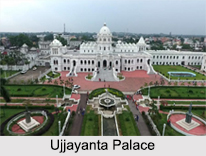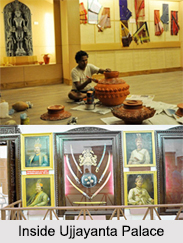 Ujjayanta Palace is a former royal palace in the capital city of Agartala, Tripura. Standing majestically as one of the major tourist attractions in the state, the Ujjayanta Palace was constructed between 1899 and 1901, by the then king of the princely state of Tripura, Maharaja Radha Kishore Manikya. The palace was named by the Nobel laureate Rabindranath Tagore.
Ujjayanta Palace is a former royal palace in the capital city of Agartala, Tripura. Standing majestically as one of the major tourist attractions in the state, the Ujjayanta Palace was constructed between 1899 and 1901, by the then king of the princely state of Tripura, Maharaja Radha Kishore Manikya. The palace was named by the Nobel laureate Rabindranath Tagore.
History of Ujjayanta Palace
Originally, the Ujjayanta Palace was built in 1862 by King Ishan Chandra Manikya, after the original palace was severely damaged by the Assam earthquake of 1897, and was rebuilt in the heart of the city of Agartala. This new modified palace was built by Maharaja Radha Kishore Manikya and at that time the project cost was almost 1 million rupees. Despite financial constraints, the project was overseen by the Martin & Burn Company and Sir Alexander Martin designed the palace in the neo classical style.
The royal palace after being established remained as the residence and the command hub of the Kingdom of Tripura, until the princely state"s accession to the Indian Government in October 1949, when the royal properties were nationalised. After this merger, the palace remained unoccupied until in 1972-73 when the main building was bought by the Tripura government from the royal family for a sum of Rs.2.5 million. It served the purpose of housing the State Legislative Assembly up till July 2011, after which it was converted into a museum at a cost of around Rs.100 million. The royal family still inhabit a small portion of the palace, on the right wing.
 Ujjayanta Palace as a State Museum
Ujjayanta Palace as a State Museum
Since 2013, the Ujjayanta Palace has become home to the Tripura Government Museum and is known to be one of the biggest museums in the region. It was inaugurated by the then Vice President of India Mohammad Hamid Ansari. The museum contains 22 galleries and showcases the art, culture, history, tradition and ethnic diversity of northeast India. The items on display include sculptures, terracotta figurines, coins, copper and stone inscriptions, bronze images, textiles, oil paintings, sketches and drawings, tribal ornaments, and musical instruments. In addition, the state archieve has been moved to Ujjayanta Palace. The museum was provided with seismic retrofitting to prevent it from possible earthquake damage.
There is a controversial past surrounding the museum"s history, where the state government"s proposal to change the name of Ujjayanta Palace to Tripura State Museum had sparked a dispute. The Indigenous Nationalist Party of Tripura (INPT) had written to the Vice President stating that the palace was not solely the property of the royal family or the government, it belongs to the people. After a candle-light rally attended by about 8000 people, the government decided to keep the original name of Ujjayanta Palace and a statue of Maharaja Radha Kishore Manikya was built on museum premises.
Architecture of Ujjayanta Palace
Spreading over a huge area of about 250 acres, the Ujjayanta Palace is built in a neo classical style and was designed by Sir Alexander Martin of the Martin and Burn Company. The architecture of the palace is an amalgamation of three distinct styles: Mughal, Roman and British. This palatial structure portrays the culture and heritage of the region.
The buildings and grounds cover 800 acres and have public rooms such as the throne room, durbar hall and library and reception hall. Along with this, the Chinese room in the palace, which has a ceiling crafted by artisans brought from China, is particularly notable. The palace is two storied and has three large domes, the largest of which is 86 ft and which rests atop a 4 storied central tower. The palace has tiled floors and carved front doors. Among the newer attractions of the palace is the musical fountain installed in front of the main entrance and the night-time floodlights. There are also several Hindu temples that occupy the plot adjacent to the palace, dedicated to Lakshmi Narayan, Uma Maheshwari, Durga and Jagannath.
Visiting Information on Ujjayanta Palace
The nearest railway station is the Agartala station at a distance of 7.4 km from the palace and the Agartala airport is the closest at a distance of almost 10 km from the Ujjayanata Palace.



















